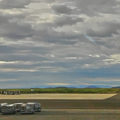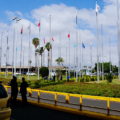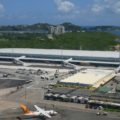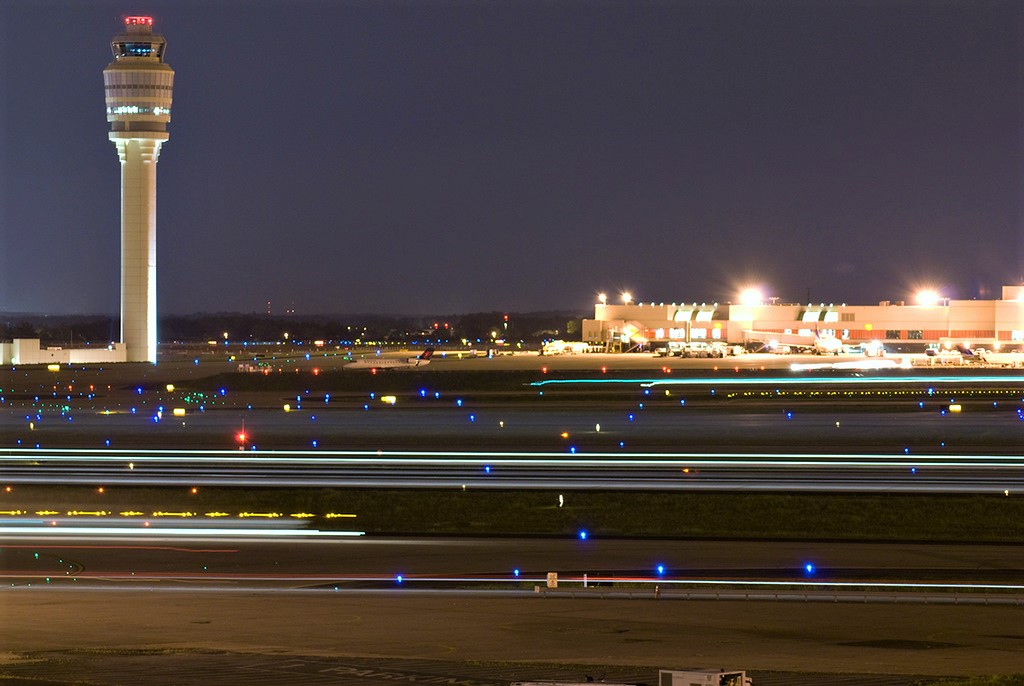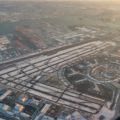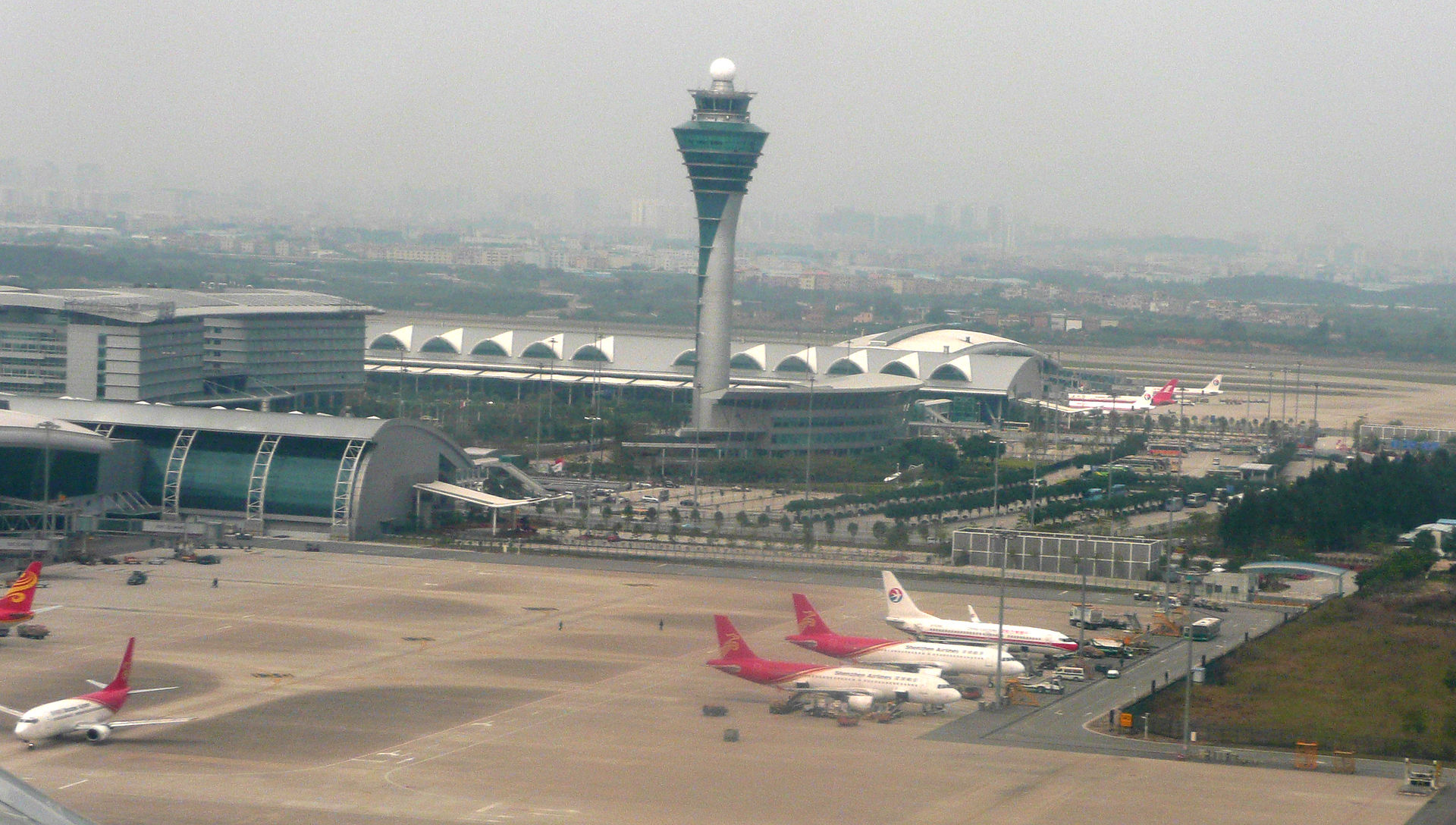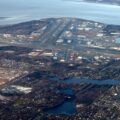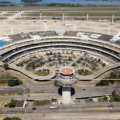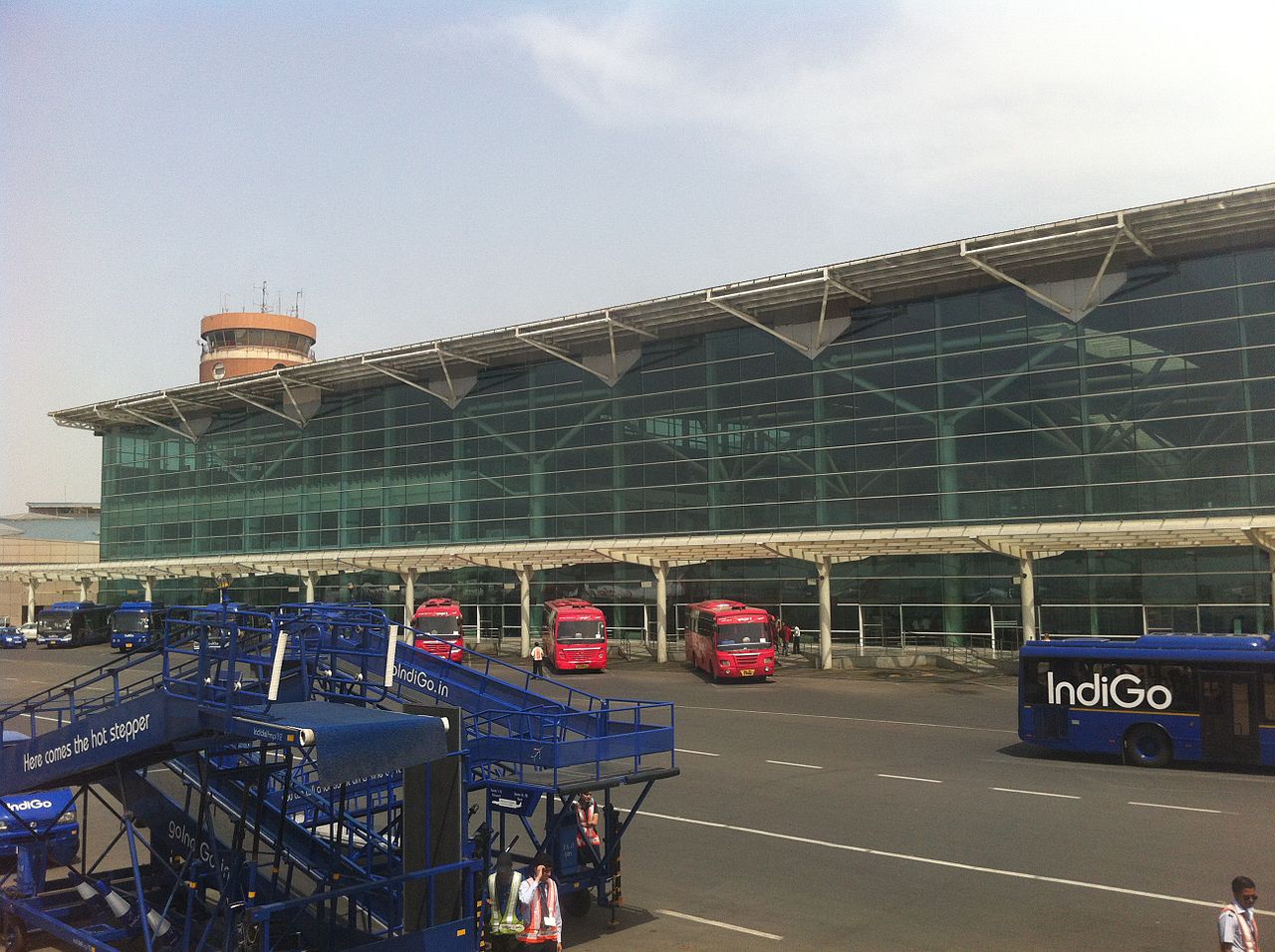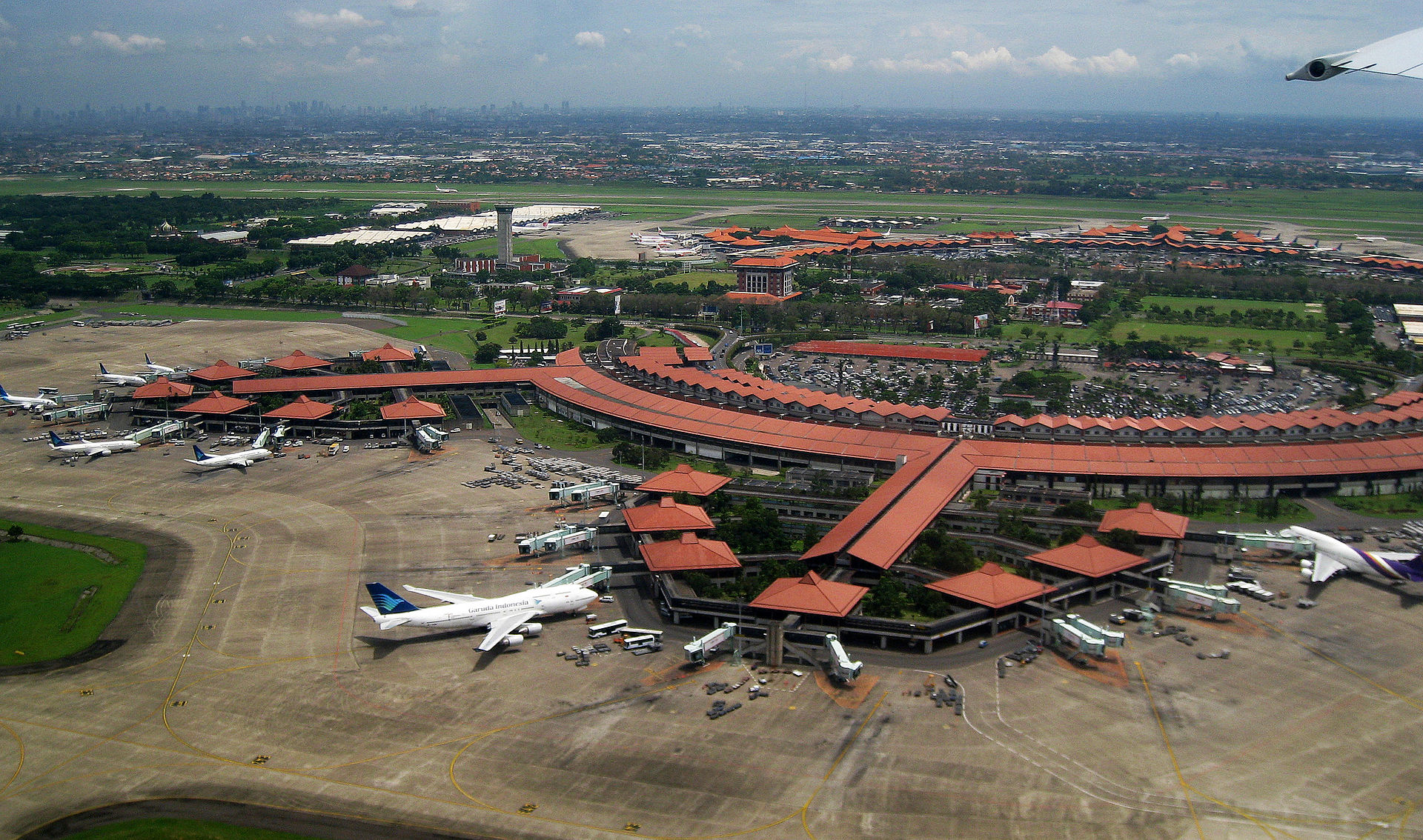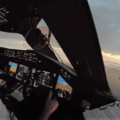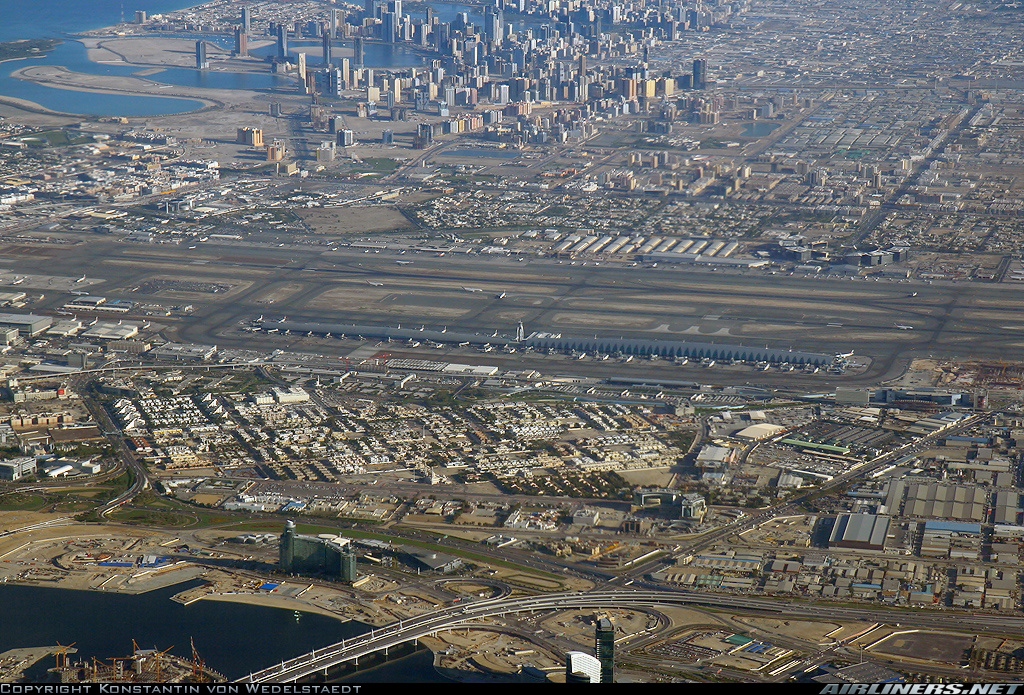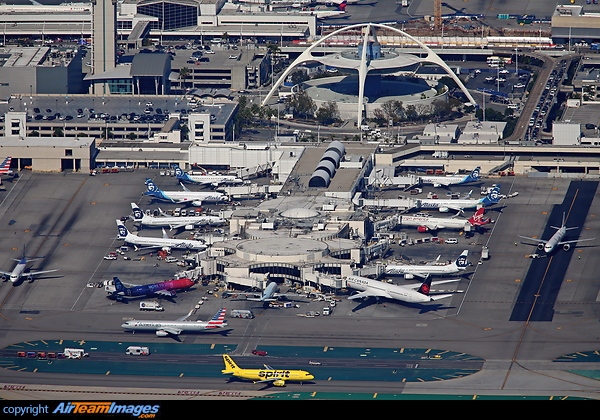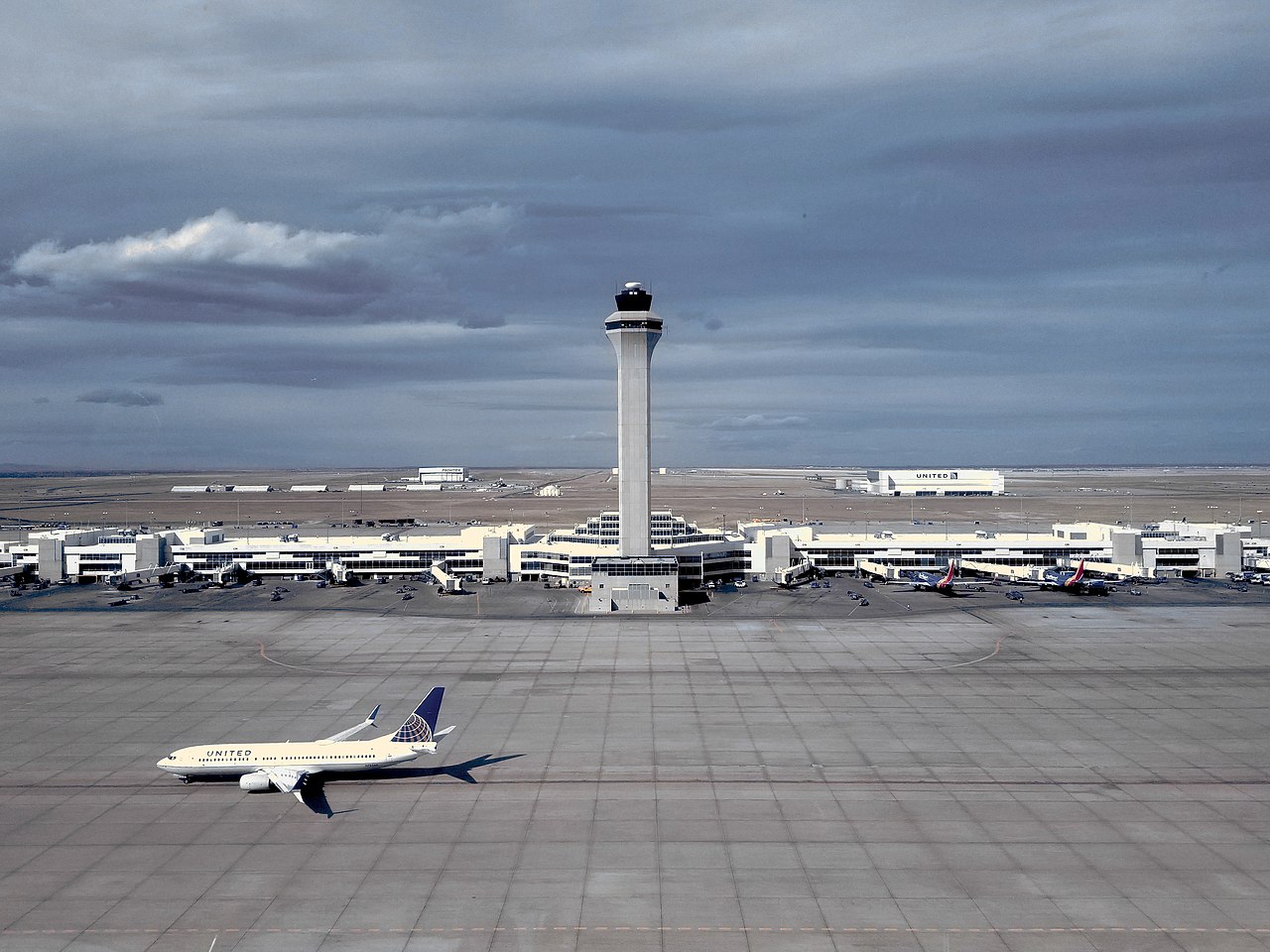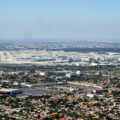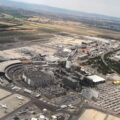Aviation
San Francisco International Airport
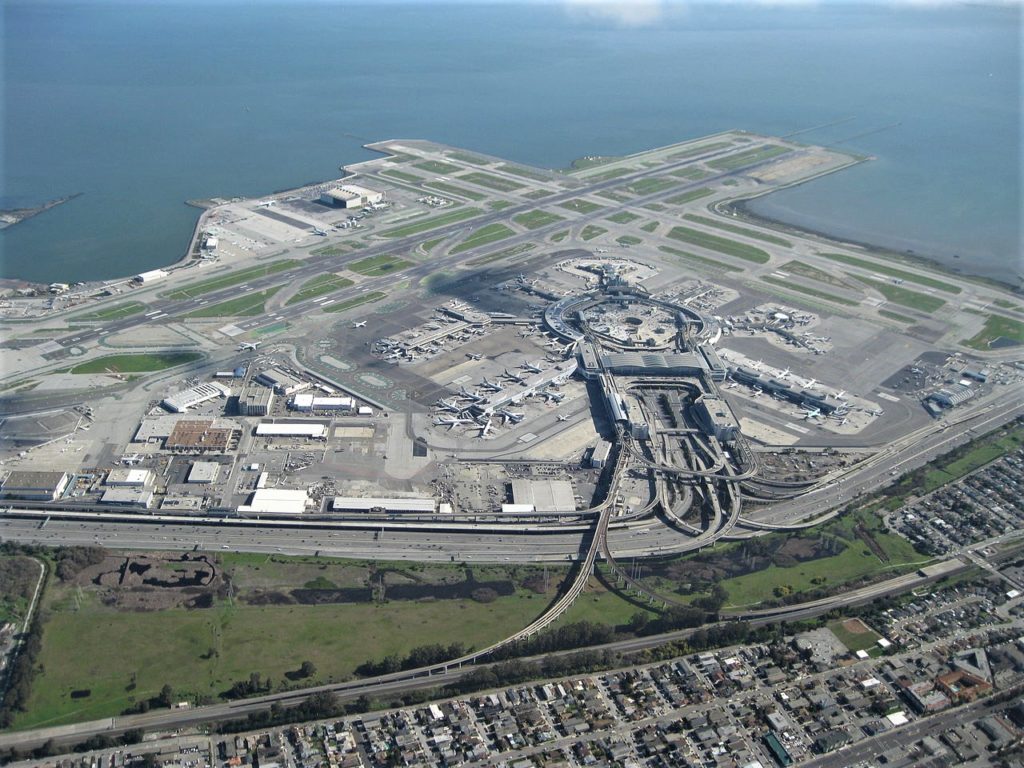
Source: Calbookaddict at English Wikipedia
| IATA: SFO ICAO: KSFO FAA LID: SFO WMO: 72494 | |
| Airport type | Public |
| Owner/Operator | City and County of San Francisco |
| Serves | San Francisco Bay Area |
| Location | Unincorporated San Mateo County, California, U.S. |
| Opened | May 7, 1927 (dedication) March 15, 1927 (start of operations) |
| Hub for | Alaska Airlines United Airlines |
| Elevation AMSL | 13 ft / 4 m |
| Coordinates | |
| Website | FlySFO.com |
San Francisco International Airport (IATA: SFO, ICAO: KSFO, FAA LID: SFO) is an international airport near San Bruno and Millbrae in unincorporated San Mateo County. It is 13 miles (21 km) south of downtown San Francisco, California, It has flights to points throughout North America and is a major gateway to Europe and Asia.
SFO is the largest airport in the Bay Area and the second busiest in California, after LAX. In 2017, it was the seventh-busiest airport in the United States and the 24th-busiest in the world by passenger count. It is the fifth-largest hub for United Airlines and functions as United’s primary transpacific gateway. It also serves as a secondary hub for Alaska Airlines. It is a major maintenance hub for United Airlines and houses the Louis A. Turpen Aviation Museum and Library.
The airport is owned and operated by the City and County of San Francisco, despite it being located in San Mateo County. Between 1999 and 2004, the San Francisco Airport Commission operated city-owned SFO Enterprises, Inc., to oversee its business purchases and operations of ventures.
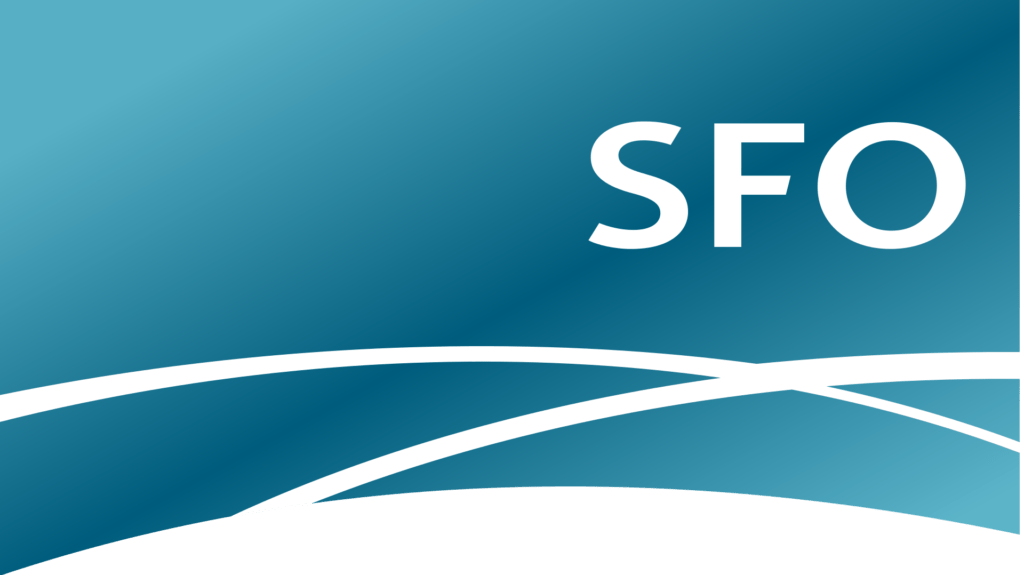

Earthquake and planned Bay fill expansion


Airport at night
Source: Andrew Choy from
Santa Clara, California
The airport closed following the Loma Prieta earthquake on October 17, 1989, reopening the following morning. Minor damage to the runways was quickly repaired.
In 1989, a master plan and Environmental Impact Report were prepared to guide development over the next two decades. During the boom of the 1990s and the dot-com boom SFO became the sixth busiest airport in the world, but since 2001, when the boom ended, SFO has fallen out of the top 20. United Express turboprops were scheduled 60 minutes apart to shuttle connecting passengers between SFO and nearby San Jose International Airport during the boom era. United Groundlink supplemented this service with alternate 60-minute frequencies.


Source: Håkan Dahlström
A $2.4 billion International Terminal Complex opened in December 2000, replacing Terminal 2 (known then as the International Terminal). The new International Terminal includes the San Francisco Airport Commission Aviation Museum and Library and the Louis A. Turpen Aviation Museum, as part of the SFO Museum. SFO’s long-running museum exhibition program, now called SFO Museum, won unprecedented accreditation by the American Alliance of Museums in 1999.
SFO experiences delays (known as flow control) in overcast weather when only two of the airport’s four runways can be used at a time because the centerlines of the parallel runway sets (01R/01L and 28R/28L) are only 750 feet (230 m) apart. Airport planners advanced proposals that would extend the airport’s runways by adding up to 2 square miles (1,300 acres; 520 ha) of fill to San Francisco Bay and increase their separation by up to 4,300 feet (1,300 m) in 1998 to accommodate arrivals and departures during periods of low visibility. Other proposals included three floating runways, each approximately 12,000 feet (3,700 m) long and 1,000 feet (300 m) wide. The airport would be required by law to restore Bay land elsewhere in the Bay Area to offset the fill. One mitigation proposal would have the airport purchase and restore the 29,000 acres (12,000 ha) of South Bay wetlands owned by Cargill Salt to compensate for the new fill. These expansion proposals met resistance from environmental groups, including the Sierra Club, fearing damage to the habitat of animals near the airport, recreational degradation (such as windsurfing) and bay water quality.
State Senator John L. Burton introduced SB 1562 on February 18, 2000 to bypass the environmental impact study that would normally be required for a large project like the proposed Bay fill and mitigation in order to expedite construction. SB 1562 was signed into law on September 29, 2000. A study commissioned by the airport and released in 2001 stated that alternatives to airport expansion, such as redirecting traffic to other regional airports (Oakland or San Jose), capping the number of flights, or charging higher landing fees at selected times of the day 2001 would result in higher fares and poorer service. However, the proposal to build new runways on Bay fill continued to attract opposition from environmental groups and local residents. The airport expansion cost was estimated at US$1,400,000,000 (equivalent to $2,200,000,000 in 2019) in 1998, rising to US$2,200,000,000 (equivalent to $3,380,000,000 in 2019) a year later, including an estimate of US$200,000,000 (equivalent to $307,000,000 in 2019) for the Cargill wetlands purchase and restoration.
The delays during poor weather (among other reasons) caused some airlines, especially low-cost carriers such as Southwest Airlines, to shift all of their service from the airport to Oakland and San Jose. However, Southwest eventually returned to SFO in 2007.
BART to SFO
A long-planned extension of the Bay Area Rapid Transit (BART) system to the airport opened on June 22, 2003, allowing passengers to board BART trains at the international or domestic terminals and have direct rail transportation to downtown San Francisco, Oakland, and the East Bay. On February 24, 2003, the AirTrain people mover opened, transporting passengers between terminals, parking lots, the BART station, and the rental car center on small automatic trains.
Recent developments
SFO became the base of operations for start-up airline Virgin America, with service to over 20 destinations. On October 4, 2007, an Airbus A380 jumbo jet made its first visit to SFO. On July 14, 2008 SFO was voted Best International Airport in North America for 2008 in the World Airports Survey by Skytrax. The following year on June 9, Skytrax announced SFO as the second-best International Airport in North America in the 2009 World Airports Survey, losing to Dallas/Fort Worth International Airport.
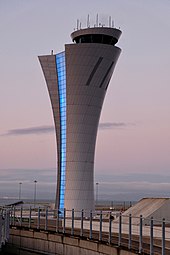

(photographed in 2018)
Source: Gregory Varnum
In response to longstanding FAA concerns that the airport’s air traffic control tower, located atop Terminal 2, could not withstand a major earthquake, on July 9, 2012, crews broke ground for a new torch-shaped tower. The new tower is located between Terminals 1 and 2, and the base of the tower building contains passages between the two terminals for passengers both pre- and post-security screening, which dictated the narrow tower base. Originally scheduled for completion in the summer of 2016 at a cost of $102 million, the new tower began operations on October 15, 2016.
SFO was one of several US airports that operated the Registered Traveler program from April 2007 until funding ended in June 2009. This program let travelers who had paid for pre-screening pass through security checkpoints quickly. Baggage and passenger screening is operated by Covenant Aviation Security, a Transportation Security Administration contractor, nicknamed “Team SFO”. SFO was the first airport in the United States to integrate in-line baggage screening into its baggage handling system and has been a model for other airports since the September 11 attacks in 2001.
In September 2018, SFO announced plans to use sustainable fuels after signing an agreement with fuel suppliers, airlines, and agencies. As part of the agreement, Shell and SkyNRG began supplying sustainable aviation fuel to KLM, SAS, and Finnair flights operatingof SFO.
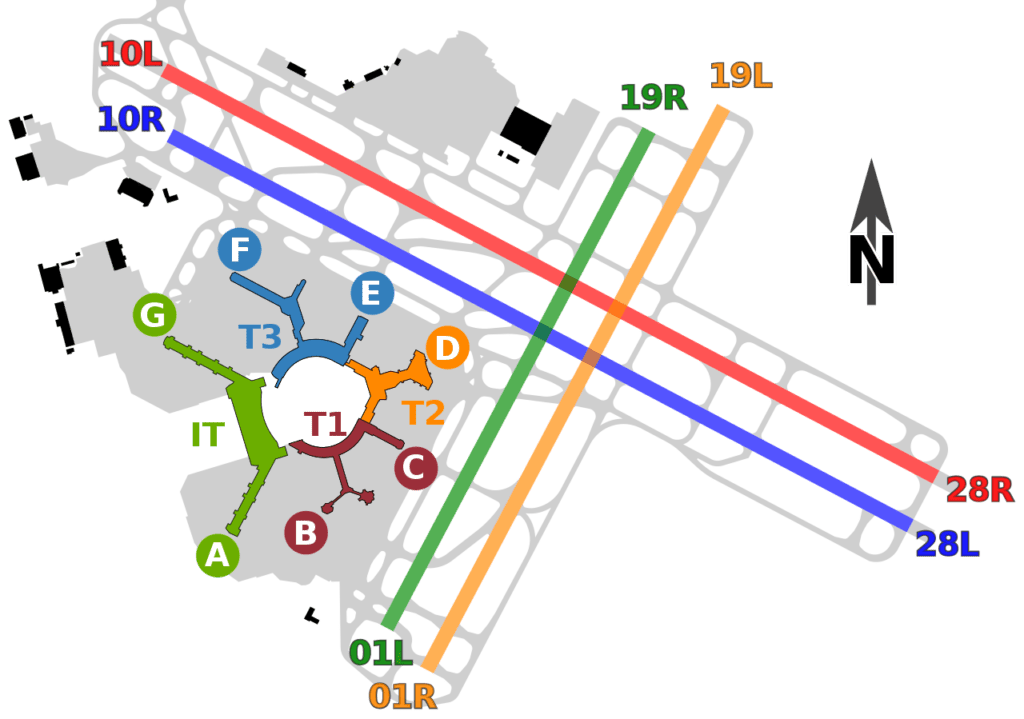

Source: Federal Aviation Administration
Runways
The airport covers 5,207 acres (21.07 km2) at an elevation of 13.1 feet (4.0 m). It has four asphalt runways, arranged in two intersecting sets of parallel runways:
- Runway 1L/19R: 7,650 ft × 200 ft (2,332 m × 61 m), Surface: Asphalt, has approved GPS approaches
- Runway 1R/19L: 8,650 ft × 200 ft (2,637 m × 61 m), Surface: Asphalt, ILS/DME equipped, and has approved GPS/VOR approaches
- Runway 10L/28R: 11,870 ft × 200 ft (3,618 m × 61 m), Surface: Asphalt, Category III ILS/DME equipped, and has approved GPS approaches
- Runway 10R/28L: 11,381 ft × 200 ft (3,469 m × 61 m), Surface: Asphalt, ILS/DME equipped, and has approved GPS approaches
Runways are named for their magnetic heading, to the nearest ten degrees; hence the runways at 14° from magnetic north are 01L/01R, and the runways at 284° are 28R/28L. The layout of the parallel runways (1L/1R and 28R/28L) was established in the 1950s, and have a separation (centerline to centerline) of only 750 feet (230 m).
During normal operations (approximately 81% of the time), domestic departures use Runways 1L and 1R for departure while overseas international departures and all arrivals use Runways 28L and 28R, taking advantage of the prevailing west-northwesterly wind coming through the San Bruno Gap. During periods of heavy winds or if operations at Oakland International Airport conflict with SFO departures (approximately 15% of the time), Runways 1L and 1R cannot be used, and so all departures and all arrivals use Runways 28L and 28R. These configurations are known collectively as the West Plan, and accommodate arrivals at a rate of up to 60 aircraft per hour. Under visual flight rules, aircraft may safely land side-by-side essentially simultaneously on 28L and 28R while maintaining visual separation.
When the visual approach is compromised, the West Plan is maintained with a modification to allow aircraft landing on 28L to use Instrument Landing System (ILS) while the aircraft landing on 28R takes an offset course, monitored via high scan rate ground radar, to maintain a lateral spacing greater than 750 ft until the aircraft can maintain visual separation. Visual separation typically occurs once the aircraft has descended below the cloud deck at an altitude of 2,100 feet (640 m). This is known as the Precision Runway Monitor/Simultaneous Offset Instrument Approach and reduces the capacity to 36 arriving aircraft per hour. In poor visibility conditions, FAA instrument approach rules require aircraft to maintain lateral separation of 4,300 feet (1,300 m), meaning only one runway may be used, reducing the capacity of SFO to 25-30 arriving aircraft per hour.
During rainstorms (approximately 4% of the time), the prevailing winds shift to a south-southeasterly direction, and departing aircraft use Runways 10L and 10R and arriving aircraft use Runways 19L and 19R. This configuration is known as the Southeast Plan.
On rare occasions (less than one day per year, on average), wind conditions dictate other runway configurations, including departures and landings on Runways 10L and 10R, departures and landings on Runways 1L and 1R, and departures on Runways 19L and 19R and landings on Runways 28L and 28R.
Based aircraft and operations
In 2018 SFO had 470,164 aircraft operations, an average of 1,287 per day. This consisted of 87% scheduled commercial, 10% air taxi, 2% general aviation and <1% military. There was 11 aircraft based at SFO, 5 jets, 1 helicopter and 5 military aircraft.
Aircraft noise abatement
SFO was one of the first airports to implement a Fly Quiet Program, which grades airlines on their performance on noise abatement procedures while flying in and out of SFO. The Jon C. Long Fly Quiet Program was started by the Aircraft Noise Abatement Office to encourage airlines to operate as quietly as possible at SFO.
SFO was one of the first U.S. airports to conduct a residential sound abatement retrofitting program. Established by the FAA in the early 1980s, this program evaluated the cost-effectiveness of reducing interior sound levels for homes near the airport, within the 65 CNEL noise contour. The program made use of a noise computer model to predict improvement in specific residential interiors for a variety of noise control strategies. This pilot program was conducted for a neighborhood in South San Francisco and success was achieved in all of the homes analyzed. The costs turned out to be modest, and the post-construction interior sound level tests confirmed the predictions for noise abatement. To date over $153 million has been spent to insulate more than 15,000 homes in the neighboring cities of Daly City, Pacifica, San Bruno, and South San Francisco.
Terminals
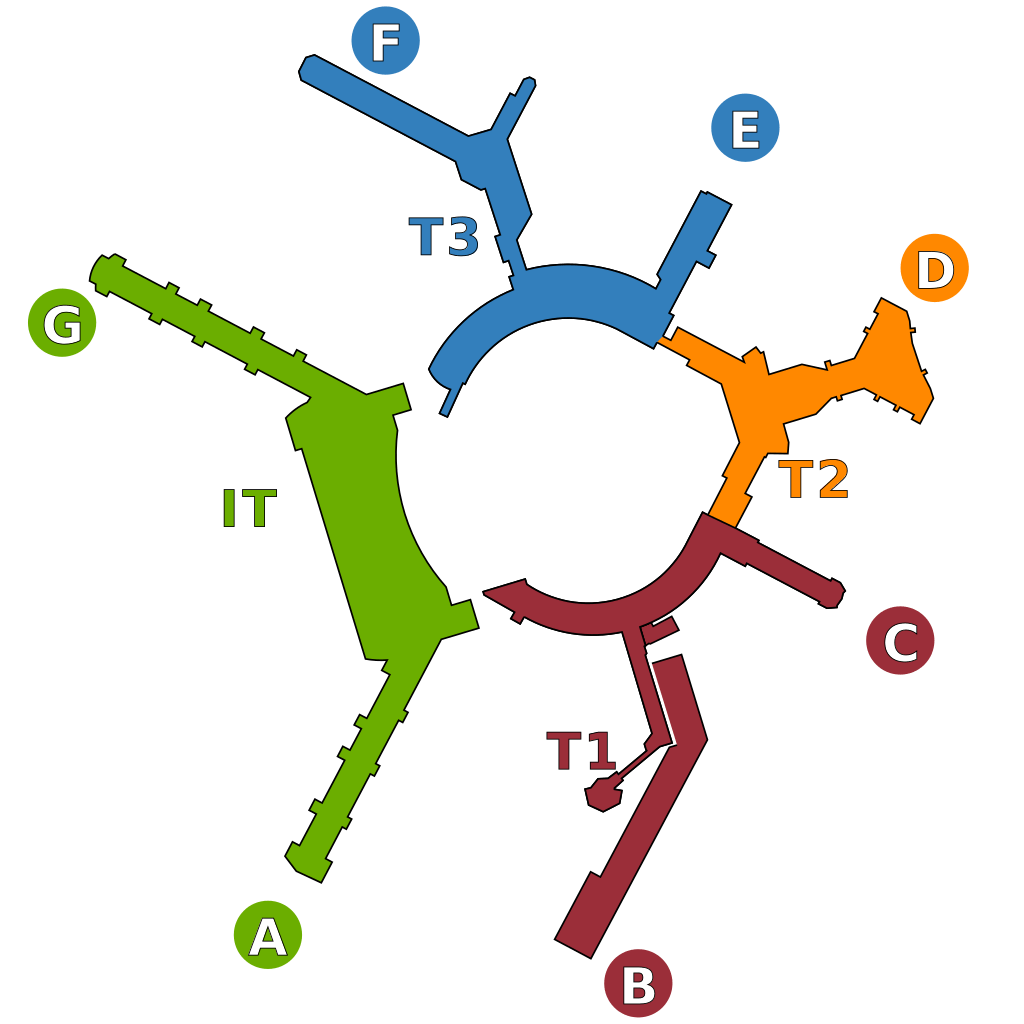

Source: Federal Aviation Administration
The airport has four terminals (1, 2, 3, and International) and seven concourses (Boarding Areas A through G) with a total of 115 gates arranged alphabetically in a counterclockwise ring. Terminal 1 (Boarding Areas B and C), Terminal 2 (Boarding Area D), and Terminal 3 (Boarding Areas E and F) handle domestic flights (including precleared flights from Canada). The International Terminal (Boarding Areas A and G) handle international flights and some domestic flights.
Historically, the oldest terminal building still standing is Terminal 2, completed in 1954 as the Central Terminal with four concourses (Piers B, C, D, and E, lettered sequentially from north to south). Terminal 1 was added as the South Terminal in 1963 with Piers F/FF (Pier F had two satellite rotundas) and G, and Pier E was reassigned to the South Terminal upon its completion. International traffic was routed through Pier G, and a new Rotunda G was completed in 1974 to expand Pier G. Terminal 3 was added as the North Terminal in 1979 with Pier A. Also once the North Terminal was completed in 1979, the piers were renamed counterclockwise, with letter designations corresponding to present-day Boarding Areas, starting with Pier A (present-day Boarding Area A, originally Pier G), Pier B (present-day Boarding Area B, originally Pier F/FF), and Pier C (present-day Boarding Area C, originally Pier E). A new Pier E was added to the North Terminal in 1981 approximately where the old Pier B stood, and the Central Terminal was rebuilt with a single pier (D) to serve international flights in 1983, until a new International Terminal opened in 2000. Since then, the terminals were renamed with numbers in 2001, and the older terminals are in the process of renovation. A rebuild of Terminal 2 (formerly the Central Terminal) completed in 2011, followed by the completed rebuild of Terminal 3 (North Terminal) in 2015, and a projected rebuild of Terminal 1 (South Terminal) is scheduled to be complete by 2024.
Airside connectors
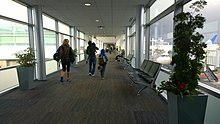

International Terminal and Terminal 3
Source: mliu92 from San Mateo
There exist two airside connectors at SFO that enable passengers to roam (post-security) between adjacent terminal buildings. A short airside connector links T3’s Boarding Area F (adjacent to Amex Centurion Lounge) to the International Terminal Boarding Area G. An airy 500-foot airside connector links T1’s Boarding Area C to T2.
There are no airside connectors between: T1 and International Boarding Area A; T2 and T3; International Boarding Areas A and G (the main terminal area of the International Terminal separates the two boarding areas). By approximately 2020 to 2022, the demolition and rebuild of the southern portion of T1 (Boarding Area B) will have been completed and an airside connector to International Boarding Area A will be added. By 2022, new airside and landside connectors and an office building will be constructed between Terminals 2 and 3. By 2024, renovation of Boarding Area C will add an airside connection between it and the rest of renovated Terminal 1. This means that all gates at the airport will be connected post-security.
Harvey Milk Terminal 1
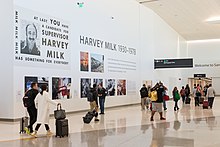

activist and former San Francisco
supervisor Harvey Milk (1930–1978)
Source: Frank Schulenburg
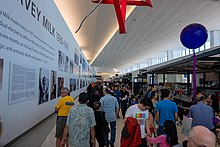

Community Day, July 2019
Source: Gregory Varnum
Formerly known as the “South Terminal”, Harvey Milk Terminal 1 is composed of Boarding Area B, which currently has 18 gates (gates B6-B9, B12-B14, B17, B18, and B19-B27), and Boarding Area C, which has 10 gates (gates C2-C11). A third boarding area, Rotunda A, was demolished in early 2006, as its functions had been taken over by the new International Terminal.
The South Terminal, which cost US$14,000,000 (equivalent to $116,920,000 in 2019), was initially dedicated on September 15, 1963. The terminal was designed by Welton Becket and Associates. When it opened, the South Terminal had three piers: Pier G (for international flights, approximately at the same location as the present-day Boarding Area (B/A) A in the International Terminal), Pier F/FF (used by Trans World Airlines (TWA) and Western Airlines, later renamed B/A B), and Pier E (used by American Airlines; originally part of Terminal 2, approximately at the present-day B/A C). The three-level Rotunda A addition was completed in 1974 at the end of Pier G. When the North Terminal was completed in 1979, Pier G was renamed Pier A, with the other piers renamed in a counterclockwise direction proceeding from the new Pier A. International flights were moved to the rebuilt Central Terminal (Terminal 2) in 1983, and then to the new International Terminal in 2000.
The South Terminal underwent a US$150,000,000 (equivalent to $324,270,000 in 2019) renovation designed by Howard A. Friedman and Associates, Marquis Associates and Wong & Brocchini that was completed in 1988. Terminal 1 is undergoing a US$2,400,000,000 (equivalent to $2,556,740,000 in 2019) project to modernize the concourse and add gates; the project broke ground on June 29, 2016. The phase of the project to expand Boarding Area B includes the demolition of the old TWA hangar, the demolition of the two rotundas, and the relocation of two taxiways. The multi-phase project will yield a total of 24 gates when complete in 2020 (the existing Boarding Area B has fewer than 20 usable gates), including a secure Federal Inspection Services (FIS) connector to the existing customs facilities in the International Terminal. This will effectively add six new gates that can handle international arrivals. Planning for a renovation of Boarding Area C is underway, with construction to commence after the completion of work on Boarding Area B. The projected completion date for Boarding Area C work is mid-2024.
In April 2018, the San Francisco Board of Supervisors and mayor Mark Farrell approved and signed legislation renaming Terminal 1 after deceased gay rights activist and former member of the San Francisco Board of Supervisors Harvey Milk, and planned to install artwork memorializing him. This followed a previous attempt to rename the entire airport after him, which was turned down. Following the art and photo installation, the renamed terminal was opened to the media and public for preview tours in advance of its official opening on July 23, 2019. Harvey Milk Terminal 1 is the world’s first airport terminal named after a leader of the LGBTQ community.
During the construction of Boarding Area B, Boarding Area C continues to operate, with Delta Air Lines operating as the main tenant. The first nine gates at the newly reconstructed Boarding Area B opened on July 23, 2019, with Southwest Airlines and JetBlue becoming the first tenants. JetBlue solely operates two gates (B6 and B7) and shares one with Southwest (B8), while Southwest solely operates six gates (B9, B12-B14, B17, and B18). In late-April 2020, the terminal’s new lobby opened, with new ticket counters for Southwest and JetBlue, and a new permanent exhibit honoring Milk. On May 12, 2020, in conjunction with the launch of nine new gates at Boarding Area B (B19-B27), American Airlines moved into the new facility, with new ticket counters, baggage systems, and a new Admirals Club lounge. American solely operates six of the nine new gates (B22-B27). Frontier Airlines, Hawaiian Airlines, and Sun Country Airlines are scheduled to move in by 2023.
Terminal 2
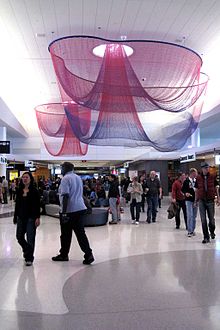

with Janet Echelman‘s
Every Beating Second installation
Source:
Itsdan
Terminal 2, formerly known as the “Central Terminal”, opened in 1954 as the main airport terminal. After a drastic rebuilding designed by Gensler, it replaced Rotunda A as SFO’s international terminal in 1983 until it was closed for renovation after the current international terminal opened in 2000. The initial plan was to convert Terminal 2 for domestic travel and reopen it by fall 2001, but the loss of passenger traffic after the terrorist attacks of September 11, 2001 put those plans on hold. The upper levels continued to be used as office spaces and for the airport’s medical clinic, and the control tower remained in use.
On May 12, 2008, a US$383,000,000 (equivalent to $454,810,000 in 2019) renovation project was announced that included a new control tower, the use of green materials, a seismic retrofit, and an expansion from ten to fourteen gates. The terminal reopened for commercial travel on April 14, 2011, with Virgin America (later Alaska Airlines) and American Airlines sharing the new 14-gate common-use facility. Approximately a week earlier, on April 6, 2011, Virgin America’s ceremonial flight VX2001 was the first to arrive at the renovated Terminal 2, an Airbus A320 bearing founder Richard Branson with other invited celebrity guests, such as Buzz Aldrin, Rachel Hunter, and Gavin Newsom. VX2001 had rendezvoused with White Knight Two/SpaceShipTwo over Point Reyes before making a side-by-side landing.


in Terminal 2
Source: Itsdan
The newly-renovated terminal also designed by Gensler features permanent art installations from Janet Echelman, Kendall Buster, Norie Sato, Charles Sowers, and Walter Kitundu. Transition zones (the immediate post-security line area for “passenger recomposure”) and exit areas (where disembarking passengers may be greeted) were designed with generous space. Terminal 2 set accolades by being the first U.S. airport to achieve LEED Gold status. Paolo Lucchesi, a local food critic, noted the sustainable food and dining program featuring local vendors and sources. Its only concourse is Boarding Area D, which has 17 gates (gates D1-D12 and D14-D18). The control tower and most operations offices were (and still are) located on the upper levels, and the departure and arrival areas served as walkways between Terminals 1 and 3.
Until May 12, 2020, American’s check-in counters were consolidated to T2, but its operations were split between T2’s Boarding Area D and T1’s Boarding Area C (linked via an airside connector). Following American’s move to T1, the existing Admirals Club location is scheduled to be repurposed as retail and dining space for T2. A new Alaska lounge is set to open in 2020.
Terminal 3


Source: Gregory Varnum
Formerly known as the “North Terminal”, Terminal 3 has Boarding Area E with 13 gates (gates E1-E13) and Boarding Area F with 23 gates (gates F1-F3, F3A, F4-F22). Terminal 3 is used for United Airlines’ domestic flights. Mainline United flights use both boarding areas, while United Express regional flights use Boarding Area F.
This $82.44 million terminal was originally designed by San Francisco Airport Architects (a joint venture of John Carl Warnecke and Associates, Dreyfuss + Blackford Architecture, and minority architects). The groundbreaking ceremony for the North Terminal was held on April 22, 1971, and Boarding Area F opened in 1979 and Boarding Area E opened in 1981. All terminals (except the International Terminal) were redesignated by number starting October 1, 2001.
A solar roof was installed in 2007 with sufficient generating capacity to power all Terminal 3 lights during the day. American Airlines and Air Canada occupied Boarding Area E until it closed for refurbishment in 2011 under the airport’s FY 2010/11 – FY 2014/15 Capital Plan. Designed by Gensler, the renovation. included architectural enhancements, structural renovations, replacement of HVAC systems, roof repair, and new carpeting. Initial modest renovation plans were replaced by a more ambitious project after the popularity of the remodeling of Terminal 2. After the completion of the US$138,000,000 (equivalent to $149,040,000 in 2019) project, Terminal 3 reopened on January 28, 2014. The project moved one gate from Boarding Area F to Boarding Area E to provide a total of ten aircraft parking positions at T3E.
There are three United Clubs in Terminal 3—one near the rotunda for Boarding Area F, one on the mezzanine across from gate E2, and another at the beginning of Boarding Area E. Terminal 3 also houses the American Express Centurion Lounge, located across from Gate F2.
International Terminal


Source: Constantine Kulikovsky
The International Terminal is composed of Boarding Areas A and G. Designed by Craig W. Hartman of Skidmore, Owings and Merrill, the terminal opened in December 2000 to replace the International Departures section of Terminal 2. It is the largest international terminal in North America, and the largest building in the world built on base isolators to protect against earthquakes. Food service focuses on quick service versions of leading San Francisco Bay Area restaurants, following other SFO terminals. Planners attempted to make the airport a destination in and of itself, not just for travelers passing through. The international terminal is a common-use facility, with all gates and all ticketing areas shared among international airlines and several domestic carriers. Common-use terminal equipment (CUTE) is used at check-in counters and gates. All international arrivals and departures are handled here (except flights from cities with customs preclearance). The International Terminal houses the airport’s BART station, adjacent to the garage leading to Boarding Area G. The SFO Medical Clinic is located next to the security screening area of Boarding Area A. All gates in this terminal have at least two jetway bridges, except gates A3 and A12, which have one. Gates A1 and A2 can accommodate two aircraft. Six of the gates are designed for the Airbus A380, making SFO one of the first airports in the world with such gates when it was built in 2000. Gate A11 has three jetways for boarding. Four other gates have two jetways fitted for A380 service.
The International Terminal completed a continuous ring of terminals, by filling in the last remaining gap to the west of then-existing terminals. Its geometry required that the terminal structure be built above the main access road, at enormous expense, including building dedicated ramps for connectivity to Highway 101. The design and construction of the international terminal was by Skidmore, Owings & Merrill, Del Campo & Maru Architects, Michael Willis Associates, and built by Tutor Perini (main terminal building), Hellmuth, Obata, and Kassabaum in association with Robin Chiang & Company, Robert B. Wong Architects, and built by Tutor Perini (Boarding Area G), and Gerson/Overstreet Architects and built by Hensel Phelps Construction (Boarding Area A). The contracts were awarded after an architectural design competition.


Terminal check-in area
Source: John Kahrs / Junkyard kahrs at
en.wikipedia
Most international flights operated by Star Alliance carriers, including all United international flights and select United domestic flights, are assigned to Boarding Area G’s 14 gates (G1-G14). Most international flights operated by SkyTeam, Oneworld, and non-aligned international carriers board and deplane at Boarding Area A’s 15 gates (gates A1–A15). However, Star Alliance carrier Avianca El Salvador operates out of Boarding Area A, and non-aligned carriers Aer Lingus, Fiji Airways, and WestJet typically park at Boarding Area G. Boarding Area A is also used by domestic carriers Frontier Airlines, Sun Country Airlines, and Hawaiian Airlines. When all gates in an airline’s designated international boarding area are full, the passengers will board or deplane from the opposite international boarding area. Air Canada, Aer Lingus, and WestJet operate from airports with United States border preclearance, allowing arriving passengers to skip the wait at customs and immigration when they arrive at SFO, and exit the airport from the departure level.
The two main designations for the International Terminal are “I”, and “INTL” (abbreviations for “International”). Oftentimes travel itineraries will say “T-I”, and this has led to instances where passengers misinterpret the “I” as Terminal 1, especially since both Boarding Area A and Boarding Area G are used for a limited number of domestic flights.
SFO Museum


Source: Cloud atlas
SFO Museum was created in 1980 as a collaboration between the San Francisco Airport Commission and the Fine Arts Museums of San Francisco and was the first museum in an international airport. It was accredited by the American Association of Museums in 1999, and contains both permanent artwork and temporary exhibitions in more than 20 galleries. The Aviation Museum and Library (officially, the San Francisco Airport Commission Aviation Library and Louis A. Turpen Aviation Museum) is located in the International Terminal, featuring a model of a DC-3. Other prominent installations include works by:
- Robert Bechtle, San Francisco Nova (T3, boarding area E)
- Kendall Buster, Topograph (T2, departure lounge)
- Janet Echelman, Every Beating Second (T2, recomposure area)
- Joyce Kozloff, Bay Area Victorian, Bay Area Deco, Bay Area Funk; tile wall (IT–T1 connector)
- Seiji Kunishima, Stacking Stones (T2)
- Ursula von Rydingsvard, Ocean Voices II (T3, E Plaza)
- Norie Sato, Air Over Under (T2, exterior)
- Larry Sultan and Mike Mandel, Waiting (IT, b/a A)
- Rufino Tamayo, Conquest of Space (IT, exterior)
- Wayne Thiebaud, 18th Street Downgrade (T3, b/a E)
- James Torlakson, Behind Ted McMann’s Garage (T3, b/a E)
- Bob Zoell, BFILRYD (T3–IT connector)
Frequent travelers and airline staff have reportedly told SFO Museum officials they make it a point to arrive to the airport early in order to view the galleries.
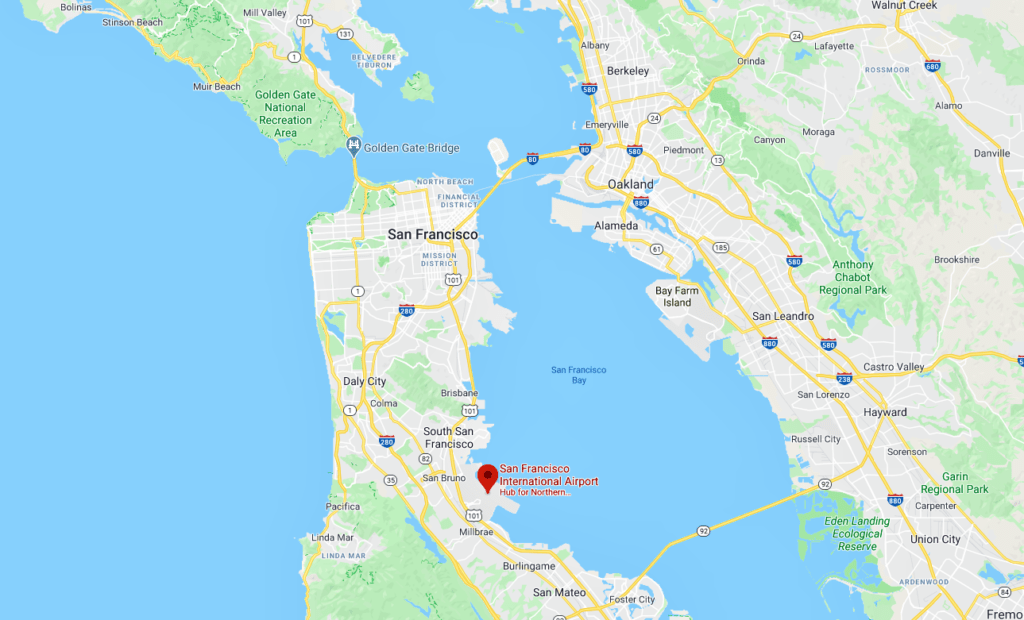

Airlines and destinations
Passenger
| Airlines | Destinations | |
|---|---|---|
| Aer Lingus | Dublin | |
| Aeroméxico | Guadalajara, Mexico City | |
| Air Canada | Montréal–Trudeau, Toronto–Pearson, Vancouver | |
| Air Canada Express | Calgary, Edmonton, Vancouver | |
| Air China | Beijing–Capital | |
| Air France | Paris–Charles de Gaulle | |
| Air India | Delhi | |
| Air New Zealand | Auckland | |
| Alaska Airlines | Austin, Boston, Chicago–O’Hare, Dallas–Love, Everett, Honolulu, Kahului, Las Vegas, Los Angeles, Newark, New York–JFK, Orange County, Orlando, Palm Springs, Phoenix–Sky Harbor, Portland (OR), Puerto Vallarta, Redmond/Bend, Salt Lake City, San Diego, San José del Cabo, Seattle/Tacoma, Spokane, Washington–Dulles, Washington–National Seasonal: Anchorage, Baltimore, Fort Lauderdale, Philadelphia | |
| Alitalia | Seasonal: Rome–Fiumicino | |
| All Nippon Airways | Tokyo–Haneda, Tokyo–Narita | |
| American Airlines | Charlotte, Chicago–O’Hare, Dallas/Fort Worth, Los Angeles, Miami, New York–JFK, Philadelphia, Phoenix–Sky Harbor | |
| American Eagle | Los Angeles | |
| Asiana Airlines | Seoul–Incheon | |
| Avianca El Salvador | San Salvador | |
| British Airways | London–Heathrow | |
| Cathay Pacific | Hong Kong | |
| China Airlines | Taipei–Taoyuan | |
| China Eastern Airlines | Kunming, Qingdao, Shanghai–Pudong | |
| China Southern Airlines | Guangzhou, Wuhan | |
| Copa Airlines | Panama City | |
| Delta Air Lines | Atlanta, Boston, Cincinnati, Detroit, Los Angeles, Minneapolis/St. Paul, New York–JFK, Salt Lake City, Seattle/Tacoma | |
| El Al | Tel Aviv | |
| Emirates | Dubai–International | |
| EVA Air | Taipei–Taoyuan | |
| Fiji Airways | Nadi | |
| Finnair | Seasonal: Helsinki | |
| French Bee | Papeete, Paris–Orly | |
| Frontier Airlines | Atlanta, Austin, Denver Seasonal: Cincinnati, Cleveland, Las Vegas | |
| Hawaiian Airlines | Honolulu, Kahului | |
| Iberia | Seasonal: Madrid | |
| Interjet | Guadalajara | |
| Japan Airlines | Tokyo–Haneda, Tokyo–Narita | |
| JetBlue | Boston, Fort Lauderdale, Long Beach, Newark (begins July 23, 2020), New York–JFK, Orlando (begins October 1, 2020), Sacramento | |
| KLM | Amsterdam | |
| Korean Air | Seoul–Incheon | |
| Level | Barcelona | |
| LOT Polish Airlines | Warsaw–Chopin (begins August 5, 2020) | |
| Lufthansa | Frankfurt, Munich | |
| Norwegian Air Shuttle | Barcelona, London–Gatwick, Paris–Charles de Gaulle Seasonal: Oslo–Gardermoen, Rome–Fiumicino | |
| Philippine Airlines | Manila | |
| Qantas | Brisbane, Melbourne, Sydney | |
| Scandinavian Airlines | Copenhagen | |
| Singapore Airlines | Hong Kong, Singapore | |
| Southwest Airlines | Burbank, Chicago–Midway, Denver, Las Vegas, Los Angeles, Ontario, Phoenix–Sky Harbor, St. Louis, San Diego | |
| Sun Country Airlines | Minneapolis/St. Paul, Portland (OR) Seasonal: Honolulu, Palm Springs | |
| Swiss International Air Lines | Zürich | |
| TAP Air Portugal | Lisbon | |
| Turkish Airlines | Istanbul | |
| United Airlines | Atlanta, Auckland, Austin, Baltimore, Beijing–Capital, Boston, Burbank, Cancún, Chengdu, Chicago–O’Hare, Cleveland, Dallas/Fort Worth, Delhi, Denver, Detroit, Dublin (begins August 3, 2020), Eugene, Fort Lauderdale, Frankfurt, Hong Kong, Honolulu, Houston–Intercontinental, Indianapolis, Kahului, Kailua–Kona, Las Vegas, Lihue, London–Heathrow, Los Angeles, Medford, Melbourne, Mexico City, Munich, Nashville, Newark, New Orleans, Ontario, Orange County, Orlando, Osaka–Kansai, Palm Springs, Papeete, Paris–Charles de Gaulle, Philadelphia, Phoenix–Sky Harbor, Pittsburgh, Portland (OR), Puerto Vallarta, Raleigh/Durham, Reno/Tahoe, Sacramento, St. Louis, San Diego, Santa Barbara, Seattle/Tacoma, Seoul–Incheon, Shanghai–Pudong, Singapore, Spokane, Sydney, Taipei–Taoyuan, Tampa, Tel Aviv, Tokyo–Haneda, Tokyo–Narita, Toronto–Pearson, Vancouver, Washington–Dulles, Washington–National Seasonal: Amsterdam, Anchorage, Boise, Bozeman, Calgary, Columbus–Glenn, Fairbanks, Kansas City, Miami, Milwaukee (begins August 3, 2020), Minneapolis/St. Paul, Omaha, San José del Cabo, Zürich | |
| United Express | Albuquerque, Austin, Bakersfield, Boise, Bozeman, Burbank, Calgary, Dallas/Fort Worth, Eugene, Eureka/Arcata, Fayetteville/Bentonville, Fresno, Kalispell, Kansas City, Las Vegas, Los Angeles, Madison, Medford, Minneapolis/St. Paul, Monterey, North Bend/Coos Bay, Oklahoma City, Omaha, Ontario, Orange County, Palm Springs, Phoenix–Sky Harbor, Portland (OR), Redding, Redmond/Bend, Reno/Tahoe, Sacramento, St. Louis, Salt Lake City, San Antonio, San Diego, San Luis Obispo, Santa Barbara, Santa Maria (CA) (begins October 1, 2020), Santa Rosa, Spokane, Tri-Cities (WA), Tucson, Vancouver Seasonal: Aspen, Eagle/Vail, Hayden/Steamboat Springs, Jackson Hole, Mammoth Lakes, Missoula, Montrose, Rapid City, Sun Valley | |
| Virgin Atlantic | London–Heathrow | |
| WestJet | Seasonal: Calgary, Vancouver |
Cargo
| Airlines | Destinations |
|---|---|
| ABX Air | Los Angeles |
| Asiana Cargo | Seoul–Incheon |
| China Airlines Cargo | Anchorage, Taipei–Taoyuan |
| DHL Aviation | Cincinnati, Los Angeles |
| EVA Air Cargo | Anchorage, Taipei–Taoyuan |
| FedEx Express | Memphis |
| Kalitta Air | Los Angeles, Seoul–Incheon |
| Korean Air Cargo | Seoul–Incheon |
| Nippon Cargo Airlines | Tokyo–Narita |
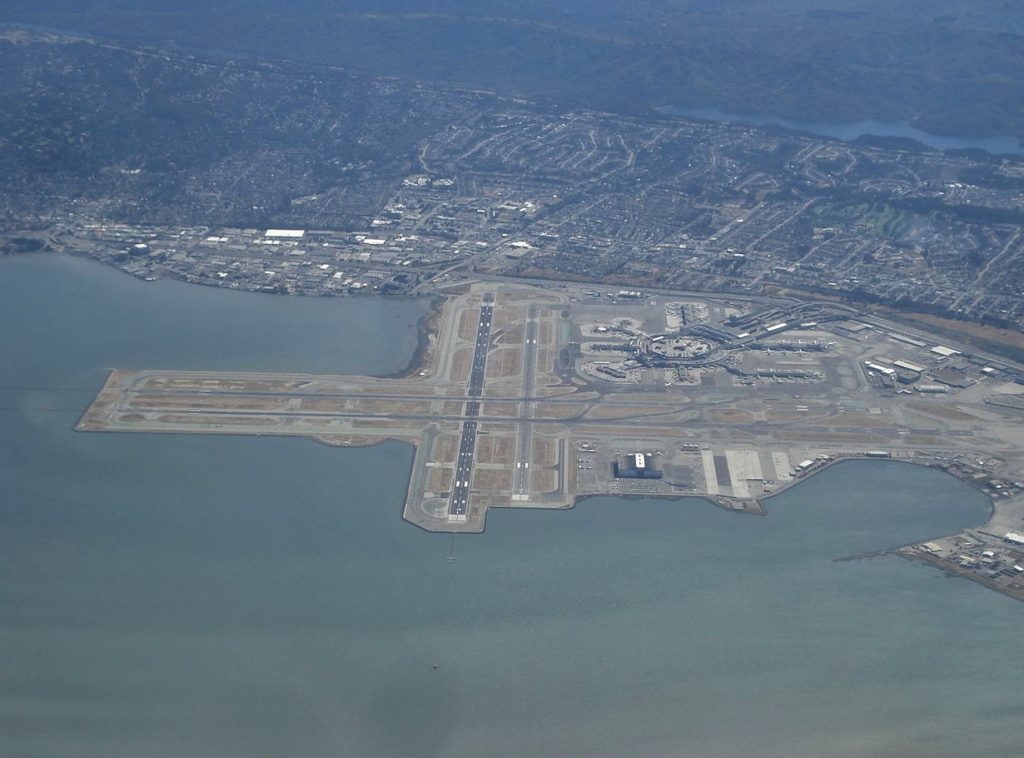

Source: Mgw89
Ground transportation
AirTrain
AirTrain is the airport’s landside people-mover system. Fully automated and free of charge, it connects all four terminals, the two international terminal garages, the BART station, the Grand Hyatt, and the airport’s Rental Car Center. An extension to the Long-Term Parking is currently underway.
Rail
BART
The San Francisco International Airport (SFO) BART station, located in Parking Garage G of the International Terminal, is the only direct rail link between the airport, the city of San Francisco, and the general Bay Area. The SFO station is served by the Antioch–SFO/Millbrae line and the SFO–Millbrae line.
Caltrain
BART is SFO’s connection to Caltrain at the Millbrae Station. Caltrain used to offer a free shuttle to SFO airport from the Millbrae station, but it was replaced by BART service when the SFO extension was completed.
Bus
The San Francisco Municipal Railway, San Francisco’s transit agency, does not provide service to the airport. However, SamTrans, San Mateo County’s transit agency, does, with six lines, SFO, 140, 292, 397, 398, and 399, connecting the Airport with Downtown San Francisco, the Peninsula, and as far south as Palo Alto. In particular:
- Route SFO direct service from the Millbrae Transit Center (Caltrain and BART).
- Route 140 provides local service from the Rental Car Center (accessible via AirTrain) to San Bruno, South San Francisco, and Pacifica, stopping at San Bruno Caltrain, San Bruno BART, and Skyline College for connections within San Mateo County and beyond.
- Route 292 serves the airport daily between San Francisco and Hillsdale Mall via Bayshore Boulevard and Downtown San Mateo.
- Route 397 operates to the airport during the overnight hours as a part of the Bay Area’s “All Nighter” service. This service mirrors that of Route 292 north of the airport (with an additional stop at Civic Center BART/Muni Metro Station), with service continuing south via Millbrae BART/Caltrain Station and El Camino Real to and from Palo Alto Caltrain.
- Route 398 serves the airport and it runs between San Francisco and Redwood City Caltrain.
- Route 399 operates to the airport during the overnight hours as a part of the Bay Area’s “All Nighter” service. This service mirrors that of Routes 120, 140, and ECR north of the airport (with an additional limited stop at Daly City BART Station), serving San Bruno and South San Francisco before terminating at Mission Street and Wellington Avenue in Daly City, where passengers can connect to MUNI’s All Nighter 14 Mission Route.
Samtrans can be accessed on the arrivals/baggage claim level of the domestic terminals and in courtyard A or G in the International Terminal.
Numerous door-to-door “shared ride” van and hotel courtesy shuttles stop at the center transportation island on the departure level, while airporter and limousine are on the arrivals/baggage claim level of the airport. Charter services are also available in the courtyards.
Car
The airport is located on U.S. Route 101, 13 miles (21 km) south of downtown San Francisco. It is near the US 101 interchange with Interstate 380, a short freeway that connects US 101 with Interstate 280.
The airport provides both short-term and long-term parking facilities.
Short term parking is located in the central terminal area and two international terminal garages. Long term parking is located on South Airport Blvd. and San Bruno Ave. and are served by shuttle buses.
Passengers can also park long-term at a select number of BART stations that have parking lots, with a permit purchased online in advance.
Taxi
Taxis depart from designated taxi zones located at the roadway center islands, on the Arrivals/Baggage Claim Level of all terminals.
Ride app services such as Uber and Lyft are available via their respective mobile app. The designated ride app pickup area for domestic terminals is on the fifth floor of the adjacent garage. The designated pickup area for the International Terminal is on the Departures/Check-In Level roadway center island.
Ferry
The airport provides free shuttle bus service to and from the South San Francisco Ferry Terminal. These shuttle buses meet San Francisco Bay Ferry services from Alameda and Oakland.
Other facilities
SFO is home to the one of the largest single aircraft maintenance bases in the world with complete MRO base operations (maintenance, repair, overhaul, painting, welding, machine shop, tool and die, parts manufacturing, fabrication, engineering, and retrofitting (Boeing and Airbus certified, among others). It serves as the principal Global MRO Base for United Airlines and serves over 40 other airlines, military customers, and aircraft lease operators.
Nippon Cargo Airlines has its San Francisco branch on the airport property.
Prior to its merger that formed Air West, Pacific Air Lines had its corporate headquarters on the grounds of the airport. Hughes Airwest, the successor to Air West, also had its headquarters on the grounds of the airport.
The United States Coast Guard operates Coast Guard Air Station San Francisco with its ramp and buildings near the cargo terminal, operating six MH-65 Dolphin helicopters.
Accidents and incidents
- On February 9, 1937, a United Airlines Douglas DC-3A-197 transport liner circled the airport, then crashed into the bay, killing 11 people.
- On September 12, 1951, United Airlines Flight 7030 plunged into the bay during a training exercise killing all three crew members.
- On April 20, 1953, Western Airlines Flight 366, a Douglas DC-6 on a scheduled evening crossbay flight to Oakland International Airport, crashed three minutes after departing SFO into San Francisco Bay. There were eight fatalities (4 crew, 4 passengers) of the 10 occupants onboard.
- On October 29, 1953, British Commonwealth Pacific Airlines flight 304, a Douglas DC-6 en route from Sydney, Australia, with fuel stops in Auckland, New Zealand, Fiji, and Honolulu, crashed on approach to SFO into Kings Mountain in San Mateo County. All 19 passengers and crew members died.
- On February 20, 1959, a Pan American DC-7C crashed and burned on the runway. The three crew members on board survived.
- On February 3, 1963, Slick Airways Flight 40 crashed and burned after striking approach lights on runway 28R, killing the four people on board.
- On December 24, 1964, Flying Tiger Line Flight 282, a Lockheed Constellation cargo aircraft departing for New York City, crashed in the hills west of the airport, killing all three crew members on board.
- On June 28, 1965, Pan Am Flight 843, a Boeing 707, had just departed for Honolulu, Hawaii, when its #4 engine exploded, causing part of the wing and the engine itself to break off and fall into the streets below. The crew was able to extinguish the ensuing fire and land safely at the nearby Travis Air Force Base.


Source: United States Coast Guard
- On November 22, 1968, a Japan Air Lines DC-8, named the Shiga, operating Flight 2, crash-landed on final approach at 9:30 a.m. on a shallow submerged reef at the eastern tip of Coyote Point (three miles short of the runway southeast of the airport). The plane was on a trip from Tokyo to San Francisco, after making a stop in Honolulu. The pilot was experienced but misread the instruments on the DC-8, which was less than a year old. There were 107 people on the plane. There were no deaths or serious injuries. The plane was salvaged by Bigge Drayage Company soon after the crash. All luggage and fuel were removed to cut the weight and the plane was lifted onto a barge and taken to the airport for repairs. The cost of repairs was $4 million and the plane re-entered service the following April. The aircraft flew for Japan Air Lines until 1983 and then several air freight companies for 18 years until it was scrapped in December 2001.
- On July 30, 1971, Pan Am Flight 845, a Boeing 747 (registration: N747PA, name: Clipper America), struck navigational aids at the end of runway 1R on takeoff for Tokyo. The aircraft’s landing gear and other systems were damaged. Two passengers were seriously injured by metal components of the runway approach light pier entering the cabin. The flight proceeded out over the Pacific Ocean to dump fuel to reduce weight for an emergency landing. Emergency services deployed at the airport, and the plane returned and landed on runway 28R. During landing, the aircraft veered off the runway. There was no fire. After coming to a stop, the aircraft slowly tilted aft, coming to rest on its tail in a nose-high attitude. The forward evacuation slides were therefore in a nearly vertical position. Evacuation using these slides caused all of the additional injuries, some severe. There were no fatalities among the 218 passengers and crew members aboard. An investigation determined that the cause of the accident was erroneous information from the flight dispatcher to the crew members regarding weight and runway length.
- On July 5, 1972, Pacific Southwest Airlines Flight 710, a Boeing 737-200, was hijacked by two Bulgarian immigrants demanding $800,000 and to be taken to the Soviet Union. After flying for an hour and landing back at SFO, the plane was stormed by four FBI agents. Both hijackers were killed along with one passenger. Two other passengers were injured.
- On September 13, 1972, TWA Flight 604, a Boeing 707-331C cargo plane crashed into the bay on takeoff. All three crew members survived.
- On October 8, 1984, a Clay Lacy Aviation Learjet 24 crashed shortly after takeoff after descending in a steep left-wing low nose attitude after entering a broken cloud at 600 feet. All three occupants (two crew, one occupant) were killed.
- On June 28, 1998, United Airlines Flight 863 was forced to shut down an engine just after takeoff, and then nearly collided with San Bruno Mountain due to improper flight procedure. The aircraft returned safely to the airport. In response, United instituted new training procedures for its flight crews.
- On September 11, 2001, United Airlines Flight 93 was destined for San Francisco. It was hijacked by four al-Qaeda terrorists and diverted towards Washington DC, with the intent of crashing the plane into either The Capitol or the White House. After learning of the previous attacks on the World Trade Center and The Pentagon, the passengers attempted to regain control of the plane. The hijackers subsequently crashed the plane in a field in Pennsylvania, killing everyone onboard.
- On May 26, 2007, an arriving SkyWest Airlines Embraer EMB 120 nearly collided with a Republic Airline Embraer 170 Regional Jet at the junction of Runways 01L and 28R. After the SkyWest EMB 120 passed the Runway 28R threshold, the Republic E-170 was cleared for takeoff on 01L, in contradiction to local and FAA orders requiring the arriving aircraft to pass the intersection before clearing departing aircraft on the intersecting runway.
- On June 28, 2008, an ABX Air Boeing 767 preparing to depart with cargo caught fire and was seriously damaged. The pilots escaped uninjured. Although the airline had received a threat the week before, investigations revealed no evidence of any malicious device on board, eventually concluding the fire was caused by an electrical system malfunction.
- On September 22, 2012, a PrimeFlight catering truck accidentally drove into the wing of a parked NetJets Gulfstream V. The wing sliced into the cab of the truck, killing the 60-year old driver.
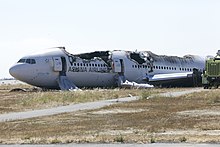

Source: NTSB
- On July 6, 2013, Asiana Airlines Flight 214, a Boeing 777-200ER registered HL7742, crashed while landing. The crash occurred due to a combination of mistakes made by the aircraft’s flight crew. The flight crew had selected an incorrect autopilot mode when attempting to descend, followed by placing the thrust levers into “idle”, which disabled the autopilot from maintaining speed as the aircraft approached the seawall. Upon descending below the desired flight path, the flight crew should have determined that their speed was too low and attempt a “go-around” and re-attempt to land; however, this decision was not made. The tail section of the aircraft struck the seawall at the end of the runway and became detached from the airframe; the plane ended up 2,000 feet (610 m) down the runway. Passengers and crew members evacuated before a fire, due to the ignition of engine lubricant, destroyed the aircraft. There were three fatalities, making this the first fatal Boeing 777 crash.
- On July 7, 2017, Air Canada Flight 759, an A320-200 was instructed by air traffic control to go around after overflying Taxiway C for 0.25 miles (400 m) while on visual approach for 28R. The A320 overflew the first two aircraft lined up on Taxiway C by roughly 100 feet (30 m). The pilots landed the aircraft afterward without incident. A total of three wide-body aircraft and one narrow-body aircraft were lined up awaiting takeoff on Taxiway C. The NTSB launched an investigation into the incident, publishing the final report in September 2018.
In popular culture
- The climax of the Steve McQueen movie Bullitt (1968) was filmed at the airport. Jet aircraft operated by Pacific Southwest Airlines (a PSA Boeing 727) and Pan American World Airways (a Pan Am Boeing 707) were prominently featured in the scenes filmed at SFO.
- The short-lived television series San Francisco International Airport (1970) was set at the airport.
- In the 1994 Dale Brown novel Storming Heaven, the airport is subject to a massive terror attack.
- The airport was used as a location of the beginning of the 1996 movie Homeward Bound II: Lost in San Francisco.
- The opening and closing scenes of What’s Up Doc (Barbra Streisand, Ryan O’Neal – 1972) were filmed in the departure/ticket and baggage claim areas of what was known as the South Terminal (now Terminal 1).
- Dirty Harry foiled a hijacking at the airport in the 1973 film Magnum Force.
- The airport was featured in the 2004 video game Grand Theft Auto: San Andreas as Easter Bay International Airport.
- The destination of the principal aircraft in the 1954 film The High and the Mighty, a Douglas DC-4, is the airport. The film’s climax takes place there, but it was filmed in Burbank, California.
- The airport stood in for Honolulu International Airport in the 2014 movie Godzilla.
- Part of the tenth episode of the fifteenth season of Family Guy, “Passenger Fatty-Seven”, took place at the airport.
- The airport appears briefly in San Andreas after being destroyed by a 9.6 magnitude earthquake.
Source: wikipedia
